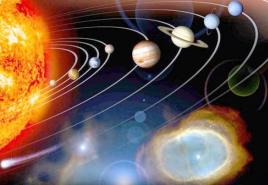How many dwarf planets are there in the solar system? Pluto and other dwarf planets of the solar system: infographics. Size and weight
Definition of the concept of dwarf planets according to international standards
The International Astronomical Union (IAU) has defined space objects that will be called dwarfs. Thus, planets that have the following characteristics are considered dwarf:
- The object revolves around the Sun;
- The mass of the object is sufficient to become almost round;
- An object cannot clear its own path with its gravity.
The main differences between the dwarf and terrestrial planets
The difference between these planets and the Earth group lies in the inability of a space object to clear a path in front of itself, that is, others, such as or Mars, can clear a path in front of themselves in their orbit with their mass. Unlike large ones, these planets, as a rule, intersect with their orbits the places of accumulation of other cosmic bodies, for example the Kuiper Belt.
To date, astronomers have been able to detect and classify five such objects:
- Pluto(a well-known planet, which at the IOC meeting in 2006 was reclassified from a planet to a dwarf planet).
- Ceres- a dwarf planet between Mars and Jupiter in the asteroid belt.
- Makemake- little studied, the third largest dwarf planet in the solar system.
- Haumea- unusual for its very rapid rotation around its axis.
- Eris- in terms of mass it is the second dwarf planet after Pluto, although it is possible that the first data is being clarified.
However, according to some scientists, it may contain about 100 or more small dwarf planets, they just haven’t been discovered yet.
The International Astronomical Union has designated the planets beyond Neptune's orbit as "Plutoids".
So it is believed that Eris, which revolves around the Sun far beyond the orbit of Neptune, becomes plutoid, and Ceres from the Asteroid Belt becomes a dwarf planet.
Table of dwarf planets with astronomical characteristics
| Dwarf planets | ||
| Location | Asteroid belt | |
| Dimensions (km) | 975×909 | |
| Weight in kg. Relative to Earth | 9.5 10 20 0,00016 |
|
| 0,0738 471 |
||
| 0,51 | ||
| Rotation period (days) | 0,3781 | |
| 0 | ||
| opening date | 01.01.1801 | |
| Pluto | Location | Kuiper Belt |
| Dimensions (km) | 2306±20 | |
| Weight in kg. Relative to Earth | 1.305 10 22 0,0022 |
|
| Average equatorial radius in km | 0,180 1148,07 |
|
| First escape velocity (km/s) | 1,2 | |
| Rotation period (days) | −6.38718 (retrograde) | |
| Number of known satellites | 5 | |
| opening date | 18.02.1930 | |
| Makemake | Location | Kuiper Belt |
| Dimensions (km) | 1500×1420 | |
| Weight in kg. Relative to Earth | ? | |
| Average equatorial radius in km | ? | |
| First escape velocity (km/s) | ? | |
| Rotation period (days) | 0.32 | |
| Number of known satellites | 1 | |
| opening date | 31.03.2005 | |
| Eris | Location | Scattered disk |
| Dimensions (km) | 2326±12 | |
| Weight in kg. Relative to Earth | ~1.67·1022 0,0028 |
|
| Average equatorial radius in km | 0,19 ~1300 |
|
| First escape velocity (km/s) | 1.3 | |
| Rotation period (days) | ≈ 1 (0.75–1.4) | |
| Number of known satellites | 1 | |
| opening date | 5.01.2005 | |
| Haumea | Location | Kuiper Belt |
| Dimensions (km) | 1960×1518×996 | |
| Weight in kg. Relative to Earth | 4.2 1021 0,0007 |
|
| Average equatorial radius in km | ~750 | |
| First escape velocity (km/s) | 0.84 | |
| Rotation period (days) | 0.16 | |
| Number of known satellites | 2 | |
| opening date | 28.12.2004 | |
| Sedna | Location | Oort cloud |
| Dimensions (km) | 995±80 | |
| Weight in kg. Relative to Earth | 8.3 1020-7.0 1021 | |
| Average equatorial radius in km | ? | |
| First escape velocity (km/s) | ? | |
| Rotation period (days) | 0.42 d (10 h) | |
| Number of known satellites | 0 | |
| opening date | 14.11.2003 | |
Other candidates for the title of dwarf planet
Thanks to modern detection means, scientists have discovered several dozen large cosmic bodies that can be classified as “Plutoid” planets. The table below shows planetoids with an approximate diameter of up to 600 km. Moreover, the first 6 objects will most likely become the main candidates.
| Name | Category | Diameter | Weight |
|---|---|---|---|
| 2015 KH 162 | Cubawano in the Kuiper Belt | 400-800 km | unknown |
| 2007 OR 10 | Scattered Disk Object | ~1535 km | unknown |
| Quaoar | Cubawano in the Kuiper Belt | 1074-1170 km | 1.0-2.6 10 21 kg |
| 2002 MS 4 | Cubawano in the Kuiper Belt | ~934 km | unknown |
| Orc | Plutino in the Kuiper Belt | 917-946 km | 6.2-7.0 10 20 kg |
| Salacia | Cubawano in the Kuiper Belt | ~921 km | 4.5 10 20 |
| 2013 FY 27 | Scattered Disk Object | ~733 km | unknown |
| Varuna | Cubawano in the Kuiper Belt | 722 km | ~5.9 10 20 kg |
| 2002 UX 25 | Cubawano in the Kuiper Belt | 681-910 km | ~7.9 10 20 kg |
| Ixion | Plutino in the Kuiper Belt | ~650 km | 5.8 10 20 |
| 2002 AW 197 | Cubawano in the Kuiper Belt | 626-850 km | ~4.1 10 20 kg |
| 2005 UQ 513 | Cubawano in the Kuiper Belt | 550-1240 km | unknown |
| Varda | Cubawano in the Kuiper Belt | 500-1130 km | ~6.1 10 20 kg |
| 2005 RN 43 | Cubawano in the Kuiper Belt | ~730 km | unknown |
| 2003 VS 2 | Plutino in the Kuiper Belt | ~725 km | unknown |
| 2007 JJ 43 | Unknown(Kuiper belt) | 609-730 km | unknown |
| 2004 GV9 | Cubawano in the Kuiper Belt | ~677 km | unknown |
| 2002 TC 302 | Scattered Disk Object | 590-1145 km | 1.5 10 21 |
| 2003 AZ 84 | Plutino in the Kuiper Belt | 573-727 km | unknown |
| 2004 XA 192 | Cubawano in the Kuiper Belt | 420-940 km | unknown |
| 2010 RE 64 | Cubawano in the Kuiper Belt | 380-860 km | unknown |
| 2010 RF 43 | Cubawano in the Kuiper Belt | ~613 km | unknown |
| Chaos | Cubawano in the Kuiper Belt | ~600 km | unknown |
| 2007 UK 126 | Scattered Disk Object | ~600 km | unknown |
| 2003 UZ 413 | Cubawano in the Kuiper Belt | ~591 km | unknown |
| 2006 QH 181 | Scattered Disk Object | 460-1030 km | unknown |
| 2010 EK 139 | Scattered Disk Object | 470-1000 km | unknown |
| 2010 KZ 39 | Scattered Disk Object | 440-980 km | unknown |
| 2001 UR 163 | Scattered Disk Object | ~636 km | unknown |
| 2010 FX 86 | Scattered Disk Object | ~598 km | unknown |
| 2013 FZ 27 | Scattered Disk Object | ~595 km | unknown |
| 2012 VP 113 | Scattered Disk Object | ~595 km | unknown |
| 2008 ST 291 | Scattered Disk Object | ~583 km | unknown |
| 2005 RM43 | Scattered Disk Object | ~580 km | unknown |
| 1996 TL 66 | Scattered Disk Object | ~575 km | 2 10 20 |
| 2004 XR 190 "Buffy" | Scattered Disk Object | 425-850 km | 0.6-4.8 10 20 |
| 2004 NT 33 | Cubawano in the Kuiper Belt | 423-580 km | unknown |
| 2004 UM 33 | Cubawano in the Kuiper Belt | 340-770 km | unknown |
| 2002 XW 93 | Scattered Disk Object | 565-584 km | unknown |
| 2004 TY 364 | Cubawano in the Kuiper Belt | ~554 km | unknown |
| 2002 XV 93 | Plutino in the Kuiper Belt | ~549 km | unknown |
The vast majority of people don't know that Pluto is now a dwarf planet in the solar system. If you don't know, there are now several of them. Of the five officially recognized, Pluto is not even the largest. There are many interesting facts about them that can be found below.

This group of celestial bodies remains the least studied so far due to their distance from the center of our system, but thanks to the constant development of technology, astronomers are constantly filling gaps in their knowledge. The years 2003-2005 were quite fruitful for openings. Modern technology allows you to see even the most distant object.
Pluto

One of the smallest objects in the solar system, with a radius of only 1153 km. The orbital period around the Sun is 90,613 days (about 248 years), and a revolution around its axis takes 6.4 Earth days. For several decades since its discovery in 1930, it was considered the ninth planet, until in 2006 astronomers came to the conclusion that it should still be classified as a dwarf planet in the Kuiper belt, which received its name after the discovery of several similar objects in 2005.
 There are currently 5 known satellites accompanying it - the largest of them are Kerberos, Nikta, Styx and Hydra. The orbit of this dwarf planet is elliptical, quite elongated .
There are currently 5 known satellites accompanying it - the largest of them are Kerberos, Nikta, Styx and Hydra. The orbit of this dwarf planet is elliptical, quite elongated .
Only a few years ago, scientists were able to measure the temperature on the surface of this celestial body. On July 14, 2015, the New Horizons spacecraft made a close flyby of Pluto and transmitted a wealth of data and photographs about it.
Haumea

The fastest rotating of all the planets known today in our system - one revolution around its own axis takes only 4 hours, while a complete flight around the Sun takes 102937 days (almost 282 years). One of the smallest objects, the average radius is only 718 km, and, unlike other celestial bodies, it has an irregular, seemingly flattened shape. At the same time, there are 2 satellites - Hiiaka and Namaka.
Makemake

The size of the third largest is still not known exactly. The average radius is assumed to be approximately 740 to within 17 km. But the length of the year on it was able to be established quite accurately - 111867 days (which is approximately equal to 306 years). No satellites were found in its orbit.
Eris

One of the largest Kuiper belt objects is only slightly larger than Pluto - 1163 km. A revolution around the Sun takes 205,029 days (slightly more than 561 years).
The scientists who discovered it in 2005 were initially confident that they had discovered the 10th planet of the solar system, but it was later recognized as a dwarf planet.
The discovery of this celestial body can be said to mark the beginning of a new era for astronomy, since it was the fact of its discovery that began numerous disputes about the status of Pluto.
Ceres

It is notable for the fact that until quite recently it was in the category of asteroids and ranked first among them in size. The length of the year, compared to other distant dwarf planets, is ridiculous, only 4.6 years.
Compared to others, its diameter is not so impressive and is 975 × 909 km. The period of rotation around the axis lasts about 0.3781 days. No satellites detected.
Classification
They have their own classification, which does not exist very much and it can be revised in the future based on new scientific discoveries.
For a long time, scientists believed that the number of planets in the solar system was limited to nine. However, the situation in the world of astronomy changed in 2006. Then one of the planets - Pluto - lost its status and began to be called dwarf. There are now hundreds of planets in the solar system that can be classified in this group. But scientists believe that there are only five dwarf planets - Pluto, Ceres, Makemake, Eris and Haumea.
Pluto is the most famous dwarf planet
Pluto is located 6 billion kilometers from the Sun. The planet was discovered completely by accident by an explorer named Clyde William Tombaugh. However, the scientist Percival Lovell put forward hypotheses about the existence of Pluto 15 years before its discovery. Pluto is the coldest celestial body in the solar system. The temperature on its surface is -223 degrees Celsius. Pluto, now classified as a dwarf planet, has a diameter of 2,374 km.
The surface of Pluto is covered with dark and light stripes. They are believed to represent methane frost deposits. Dark streaks are older gas deposits. According to scientists, the entire planet is covered with a layer of methane ice. That is why the temperature on its surface does not exceed -230 degrees Celsius.
Pluto's atmosphere consists entirely of three chemical substances - the gases argon, methane and neon and is divided into two parts, between which there is an aerosol layer. Even in summer, the temperature of the planet does not rise above -209 degrees Celsius.

Research of trans-Neptunian objects
Astronomers who studied Neptune have always suspected that the sky above it is not as “clean” as it might seem at first glance. Scientists believed that above it there was a belt of as yet unexplored celestial bodies. The discovery occurred in 1992 - then for the first time, astronomers were able to observe a new object, later classified as a “dwarf planet”. The very next year, a similar planet was found, and by 1996, the number of discovered celestial bodies began to be 32. Currently, astronomers have already discovered more than a thousand so-called trans-Neptunian objects.
Scientists called this group the Kuiper belt. At least one of this category is larger than Pluto. This is the small planet Eris. Then the researchers were faced with a choice: it was necessary either to include a huge number of objects in the list of planets of the Solar System - more than a thousand; or deprive Pluto of its planetary status. Ultimately, astronomers chose the latter path, separating these small celestial bodies into a separate category - dwarf planets.

Eris is a planet named after the goddess of enmity
After scientists assigned Pluto the title of dwarf planet in 2006, controversy over this decision continues. The name of the celestial body, which was discovered by astronomer Michael Brown from California, could not be more appropriate for the current situation. In ancient Greek mythology, Eris was the goddess of discord and quarrels. It was she who provoked jealousy among the Olympian gods, which led to the Trojan War. The dwarf planets of the solar system also provoke a lot of controversy between astronomers.
The planet has a single satellite - a celestial body called Dysnomia. This planet is named after the daughter of the ancient Greek goddess, who in mythology represented the spirit of lawlessness. In its physical dimensions, Eris does not exceed Pluto. But it is a quarter more massive than the planet that lost its status. Eris makes its revolution around the Sun in 557 years.

Dwarf planet Haumea
How many dwarf planets are there in the solar system? The International Union of Astronomers has recognized this status for five planets: in addition to Pluto and Eris, these are Ceres, Makemake and Haumea. However, scientists presumably attribute about 40 more objects to this group.

The dwarf planet Haumea was discovered by astronomer Brown in 2004. In terms of its transverse diameter, the range of which is 1212–1491 km, Haumea can be compared with Pluto. But this dwarf planet is not round in shape, but more elongated, reminiscent in its contours of a ball used in American football. Haumea rotates around its axis in 4 hours. The planet is named after the Hawaiian goddess of fertility. Three quarters of its surface is covered with a layer of ice. The dwarf planet makes a revolution around the Sun in 283 years.
Planet Makemake
Astronomers from Brown's team, who studied small dwarf planets, made another discovery in 2005. This time it was a planet called Makemake. The celestial body was named in honor of the fertility deity, who was revered in Polynesia. Its orbit is even further than Pluto. Makemake makes a revolution around the Sun in 310 years. The dwarf planet is the second brightest in the entire Kuiper belt. Scientists believe that Makemake is also covered in a thick layer of frozen methane.
Ceres is a dwarf planet discovered earlier than others
Many people are interested in which planet is dwarf, but does not belong to the Kuiper belt? This is Ceres, whose orbit is between Mars and Jupiter. Ceres orbits the main body of the solar system every 4.6 years. It is the largest celestial body in the asteroid belt. The dwarf planet is named after the ancient Roman goddess, who personified maternal love and fertility. It was opened quite a long time ago - in 1801. It was discovered by the Italian scientist Giuseppe Piazzi. Modern astronomers believe that Ceres is a rocky core that is covered with a mantle of water and ice.
Of course, these are just figurative comparisons. In reality, there are giant planets and dwarf planets.
Giant planets
These are the planets known to us, which we have already talked about more than once on our website: Jupiter, Saturn, Uranus, Neptune. All of them are located outside the ring of minor planets (asteroids). In terms of their physical characteristics, they are very similar, so they are combined into one group - outer planets, or gas giants. What are these physical characteristics? Significantly larger sizes and masses (as a result of this, the pressure in their depths is much higher), lower average density (close to the solar average, 1.4 g/cm³), powerful atmospheres, rapid rotation, and rings (while there are no terrestrial planets) and a larger number of satellites.
Why are these giant planets called gas planets? Because they are mainly composed of gas (mainly hydrogen and helium). Scientists believe that gas giant planets formed earlier than the terrestrial planets. When most of the refractory substances (oxides, silicates, metals) fell out of the gas phase, the inner planets (from Mercury to Mars) were formed from them.
The period of rotation of gas planets around their axis is only 9–17 hours.

The picture shows gas giant planets compared to the Sun.
Presumably, gas giants have a small rocky or metallic core, and the pressure in their atmosphere is so high that hydrogen turns into a liquid state. And if the planet is especially large, then below this layer of liquid hydrogen there may be another layer of metallic hydrogen (like liquid metal). Scientists have also found that all gas planets emit more heat than they receive from the Sun. This can be explained by the fact that either the planets are gradually shrinking, or thermonuclear reactions are taking place in them. Thermonuclear reaction- a type of nuclear reaction in which light atomic nuclei combine into heavier ones due to the kinetic energy of their thermal motion.
In the atmospheres of gas planets, powerful winds blow at speeds of up to thousands of kilometers per hour, and atmospheric formations there form giant vortices. For example, the Great Red Spot, several times larger than Earth, has been observed on Jupiter for more than 300 years. There is a Great Dark Spot on Neptune and smaller spots on Saturn.
Only large planets can be gas, since small celestial bodies are not capable of holding such a light gas as hydrogen.
Everything that we have said here about the gas giant planets refers to the group of outer planets of the Solar System. But gas giant planets also exist outside the solar system. The largest known gas planet is TrES-4b.
Planet TrES-4b

It is a gas giant, one of the largest known planets, and is 70% larger than Jupiter. The picture shows Jupiter and TrES-4b in comparison. This planet is located in the constellation Hercules and orbits the star GSC02620-00648. It is 1435 light years away from Earth. To make it clear how enormous this distance is, let’s explain what a light year is. Light year(sv. g., ly) - an extra-system unit of length equal to the distance traveled by light in one year. And if we take into account that 1 light second ≈ 299,792.5 km, then we can calculate the distance to the planet TrES-4b. It is interesting that this planet was discovered by amateur astronomers.
Dwarf planets
The characteristics of this type of planet were given by the International Astronomical Union. Dwarf planets should not be confused with the minor planets of the solar system, or asteroids.
So, according to the classification of the International Astronomical Union, adopted in 2006, dwarf planets is a celestial body that:
orbits the Sun;
has sufficient mass to maintain hydrostatic equilibrium under the influence of gravity and have a close to round shape;
is not a satellite of the planet;
does not dominate its orbit (cannot clear space from other objects).
Bodies large enough to clear the vicinity of their orbit are considered planets, but not big enough - small bodies of the solar system, or asteroids. Dwarf planets occupy an intermediate position between these two categories. Not all astronomers agree with this classification, but for now it is so.
There are five officially recognized dwarf planets: Ceres, Pluto, Haumea, Makemake, Eris. It is interesting that from this list only Pluto was “demoted”, becoming a dwarf planet and losing its status as a planet, while the rest, on the contrary, were “promoted”, ceasing to be just one of the asteroids.
It is possible that at least another 40 of the known objects in the solar system belong to this category. Scientists estimate that up to 200 dwarf planets may be discovered in the Kuiper Belt and up to 2,000 dwarf planets beyond it. All this is within the solar system. The Kuiper Belt is the region of the Solar System from the orbit of Neptune to a distance of about 55 AU. e. from the Sun.
The classification of bodies with the characteristics of dwarf planets in other planetary systems has not yet been determined.
Ceres
Ceres is the dwarf planet closest to Earth; it is 263 million km away from Earth. It was discovered in 1801 by the Italian astronomer Giuseppe Piazzi at the Palermo Astronomical Observatory. Its diameter is about 950 km, and today Ceres is the largest and most massive body in the asteroid belt. Recent observations have shown that it is spherical, unlike most small bodies, which have an irregular shape due to low gravity. Ceres' surface is likely a mixture of water ice and various minerals such as carbonates and clays. Ceres is thought to have a rocky core and an icy mantle, and may even contain oceans of liquid water beneath its surface. Ceres has a mass of 9.5 1020 kg and an orbital period of 4.599 years. The average surface temperature is 167K.

Structure of Ceres:
1 - thin layer of regolith;
2 - ice mantle;
3 - stone core.
From Earth, Ceres's apparent brilliance ranges from magnitude 6.7 to 9.3, making it indistinguishable to the naked eye. On September 27, 2007, NASA launched the Dawn probe to study Vesta (2011-2012) and Ceres (2015). No satellites have yet been discovered around Ceres.
Pluto

Along with Eris, it is the largest dwarf planet in the Solar System in size and the tenth largest celestial body orbiting the Sun in terms of mass (excluding satellites). Pluto was originally classified as a planet, but is now considered one of the largest objects (possibly the largest) in the Kuiper Belt. Like most objects in the Kuiper Belt, Pluto is composed primarily of rock and ice.
Pluto was discovered back in the 19th century, but it was given a name only in 1930 - this date is considered the date of its discovery. It was considered the ninth planet in the solar system until 2006, but then objects were discovered in the outer solar system, such as Eris, which were more massive than Pluto, and the International Astronomical Union ranked it in the new category of dwarf planets, along with Eris and Ceres.
Pluto's orbit is highly inclined (17º), the average distance of Pluto from the Sun is 5.913 billion km. Pluto is in an orbital resonance of 3:2 with Neptune - for every three revolutions of Neptune around the Sun, there are two revolutions of Pluto, the entire cycle takes 500 years. Orbital resonance is a situation in which two (or more) celestial bodies have orbital periods that are related as small natural numbers. As a result, these celestial bodies exert a regular gravitational influence on each other, which can stabilize their orbits. If Pluto was not initially in resonance with Neptune, then it probably came much closer to it from time to time, and these approaches over billions of years affected Pluto, changing its orbit and turning it into the one observed today. Calculations have made it possible to establish that over millions of years the general nature of the interactions between Neptune and Pluto does not change.
Among the objects of the Solar System, Pluto is not only smaller in size and mass in comparison with the other planets, it is even inferior to some of their satellites. Pluto's atmosphere is a thin shell of nitrogen, methane and carbon monoxide evaporating from the surface ice. It was recently calculated that the surface temperature of Pluto is 43 K.
Five natural satellites of Pluto are known, three of them have names today: Charon, discovered in 1978 by astronomer James Christie, and two small satellites, Nikta and Hydra, discovered in 2005. The fourth satellite was discovered using the Hubble telescope; a message about the discovery was published on July 20, 2011 on the telescope’s website. It was temporarily named S/2011 P 1 (P4); its dimensions range from 13 to 34 km. On July 11, 2012, the discovery of Pluto's fifth moon was announced.

It is the fourth largest dwarf planet in the Solar System, located in the Kuiper Belt, with a diameter of more than 100 km. Haumea has a highly elongated shape. She has 2 satellites discovered. Haumea was discovered independently by American and Spanish teams of astronomers in 2004. Haumea is an unusual planet. It rotates very quickly - its rotation period around its own axis is 3.9155 hours. Very fast rotation distorts its shape.
In 2005, Haumea's spectrum was studied using telescopes at the Gemini and Keck Observatories. As a result, it was discovered that its surface is covered predominantly with water ice in the form of grains with a diameter of 25 or 50 microns. Haumea has two satellites. Its mass is 4.2 1021 kg, the average surface temperature is unknown.

Makemake is the third largest dwarf planet in the solar system. Refers to trans-Neptunian objects, plutoids. It is the largest known classical Kuiper belt object. Makemake was discovered by a group of American astronomers in 2005. As of 2012, Makemake is located 7.8 billion km from the Sun. This is a fairly bright object, it can be photographed through a powerful amateur telescope. The size and mass of Makemake are not exactly known. The orbital period is 248.09 years. The average surface temperature is also unknown.
When exploring Makemake with the Spitzer and Herschel space telescopes, it was discovered that Makemake's surface is heterogeneous. Although most of the surface is covered with methane snow, there are small areas of darkened terrain. Researchers have found that its surface is similar in chemical composition to the surface of Pluto. No satellites have been detected in orbit around Makemake.

The most massive of the dwarf planets in the Solar System, located in the Scattered Disk. Previously known as Xena. Eris has long been considered significantly larger than Pluto, but, according to the latest data, their sizes are so close that it is impossible to say with certainty which of these objects is larger. Eris was discovered by a group of American astronomers in 2005. The average distance of Eris from the Sun is 10.18 billion km, but its orbit is highly elongated. It is impossible to directly observe the planet with an amateur telescope. It is very difficult to accurately determine the size of such a distant celestial body. Measurements of the size of Eris, carried out in 2007 using the Spitzer infrared space telescope, made it possible to estimate its diameter at ~ 2600 + 400 km. The question of which dwarf planet - Pluto or Eris - is actually the largest in the solar system remains open. The mass of Eris was determined due to the presence of a satellite; it is greater than the mass of Pluto and is equal to 1.67 1022 kg. According to a photometric study conducted in 2006, Eris makes a complete revolution around its axis in at least 5 Earth days. Spectroscopic observations in 2005 at the Gemini Observatory showed the presence of methane snow on the surface of Eris, which makes it similar to Pluto and Neptune's moon Triton. Eris is different from Pluto and Triton in color. Pluto and Triton are reddish, and she is grayish. This is due to the presence of ethane and ethylene ice on Eris. Eris has 1 known satellite. The orbital period is 557 years, the average surface temperature is 30K.
Dwarf planets didn't actually exist until 2006. Then they were allocated to a new class. The purpose of such a transformation was to introduce an intermediate link between large planets and numerous asteroids to prevent confusion in the names and statuses of new bodies discovered beyond the orbit of Neptune.
Definition
Then, back in 2006, the next meeting of the IAU (International Astronomical Union) took place. On the agenda was the question of specifying the status of Pluto. During the discussions, it was decided to deprive him of the “title” of the ninth planet. The IAU has developed definitions for some space objects:
- A planet is a body orbiting the Sun that is massive enough to maintain hydrostatic equilibrium (that is, have a rounded shape) and clear its orbit of other objects.
- An asteroid is a body orbiting the Sun that has a low mass that does not allow it to achieve hydrostatic equilibrium.
- A dwarf planet is a body orbiting the Sun that maintains hydrostatic equilibrium, but is not massive enough to clear its orbit.
Pluto was included among the latter.
New status
Pluto is also classified as a Kuiper belt body. Like some other dwarf planets, it is classified as a Kuiper belt body. The impetus for revising the status of Pluto was the numerous discoveries of objects in this distant part of the solar system. Among them was Eris, which exceeds Pluto in mass by 27%. Logically, all these bodies should have been classified as planets. That is why it was decided to revise and specify the definitions of such space objects. This is how dwarf planets appeared.
Tenth

It wasn't just Pluto who was "demoted in rank." Eris, before the IAU meeting in 2006, claimed the “title” of the tenth planet. It surpasses Pluto in mass, but is inferior to it in size. Eris was discovered in 2005 by a group of American astronomers searching for trans-Neptunian objects. Initially she was called Xena or Zena, but later they began to use the modern name.
Eris, like other dwarf planets in the Solar System, has hydrostatic equilibrium, but is not able to clear its orbit of other cosmic bodies.
Third on the list

The next largest after Pluto and Eris is Makemake. This is a classic Kuiper belt object. The name of this body has an interesting story. As always, upon opening it was assigned the number 2005 FY 9. For a long time, the team of American astronomers that discovered Makemake called it among themselves the “Easter Bunny” (the discovery was made a few days after the holiday).
In 2006, when a new column “Dwarf planets of the Solar System” appeared in the classification, it was decided to call 2005 FY 9 differently. Traditionally, classical Kuiper Belt objects are named after deities associated with creation. Make-make is the creator of humanity in the mythology of the Rapanui people, the original inhabitants of Easter Island.
Haumea

The dwarf planets of the Solar System also include another trans-Neptunian object. This is Haumea. Its main feature is very fast rotation. In this parameter, Haumea is ahead of all known objects with a diameter of more than one hundred meters in our system. Among dwarf planets, the object ranks fourth in size.
Ceres

Another one belonging to this class is located in the Main, lying between the orbits of Jupiter and Mars. This is Ceres. It was opened at the beginning of 1801. For some time it was considered a full-fledged planet. And in 1802, Ceres was classified as an asteroid. The status of the cosmic body was revised in 2006.
Dwarf planets differ from their large neighbors mainly in their inability to clear their own orbit from other bodies. It is difficult to say now how convenient such an innovation is to use - time will tell. In the meantime, the controversy over the downgrading of Pluto's status has only subsided a little. However, the value of the former ninth planet and similar bodies for science remains high regardless of what they are called.







